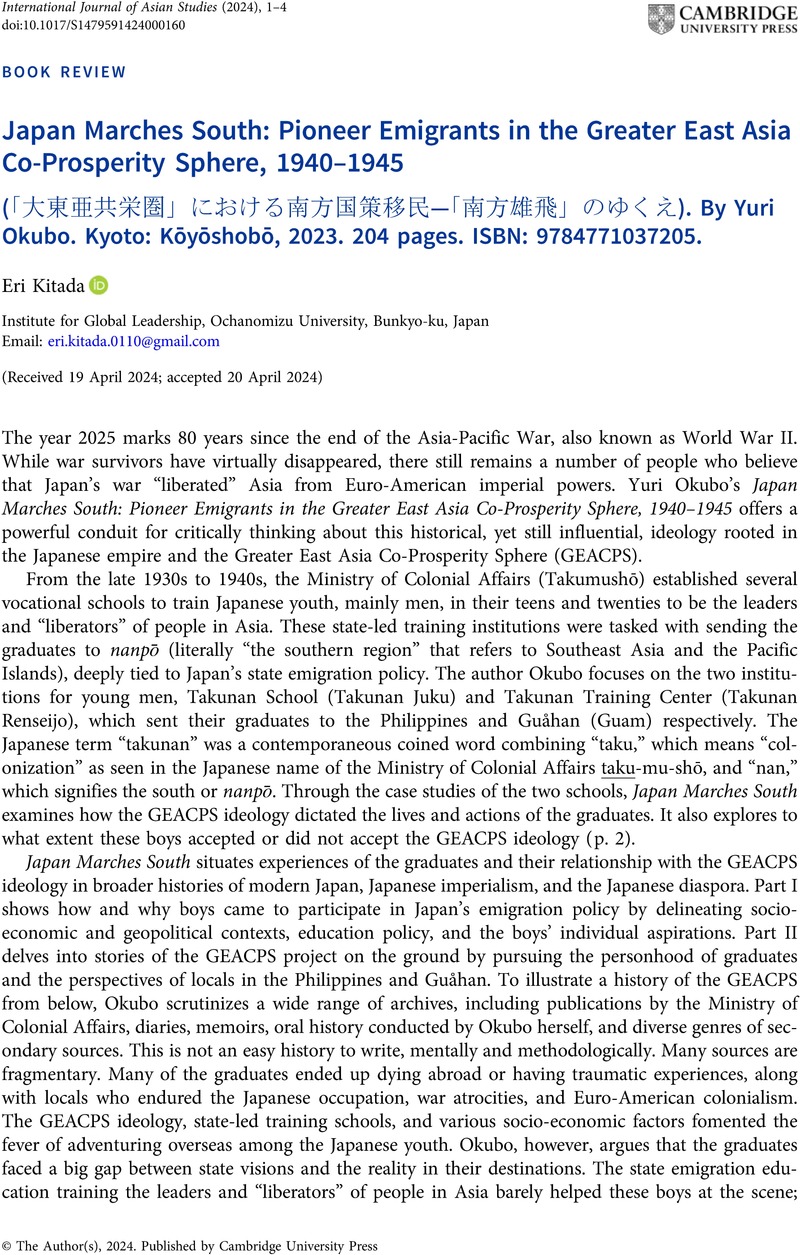No CrossRef data available.
Article contents
Japan Marches South: Pioneer Emigrants in the Greater East Asia Co-Prosperity Sphere, 1940–1945 (「大東亜共栄圏」における南方国策移民―「南方雄飛」のゆくえ). By Yuri Okubo. Kyoto: Kōyōshobō, 2023. 204 pages. ISBN: 9784771037205.
Review products
Japan Marches South: Pioneer Emigrants in the Greater East Asia Co-Prosperity Sphere, 1940–1945 (「大東亜共栄圏」における南方国策移民―「南方雄飛」のゆくえ). By Yuri Okubo. Kyoto: Kōyōshobō, 2023. 204 pages. ISBN: 9784771037205.
Published online by Cambridge University Press: 15 May 2024
Abstract
An abstract is not available for this content so a preview has been provided. Please use the Get access link above for information on how to access this content.

- Type
- Book Review
- Information
- Copyright
- Copyright © The Author(s), 2024. Published by Cambridge University Press
References
Barriga, M.C.B. (2020). The ‘Japanese’ Locals of Davao and of Guam: Shifting Belongings amidst Successive Empires during and after the Pacific War (PhD thesis). Waseda University.Google Scholar
Census Office of the Philippine Islands (1921). Census of the Philippine Islands: Taken Under the Direction of the Philippine Legislature in the Year 1918. Vol. 2. Manila: Bureau of Printing.Google Scholar
Chatani, S. (2018). Nation-Empire: Ideology and Rural Youth Mobilization in Japan and Its Colonies. Ithaca: Cornell University Press.CrossRefGoogle Scholar
Commonwealth of the Philippines Commission of the Census (1941). Census of the Philippines: 1939. Vol. 2. Manila: Bureau of Printing.Google Scholar
Hasegawa, T. ed. (2020). Ego-dokyumento no rekishigaku [History with Ego-Documents]. Tokyo: Iwanami shoten.Google Scholar
Ito, T. and Morita, N. eds (2023). Kyо̄kan no kyо̄dо̄tai: Kanjо̄shi no sekai wo hiraku [Empathizing Communities: An Invitation to the History of Emotion]. Tokyo: Heibonsha.Google Scholar
Kwon, N.A. (2015). Intimate Empire: Collaboration and Colonial Modernity in Korea and Japan. Durham: Duke University Press.Google Scholar
Mason, M. and Lee, H.J.S. eds (2012). Reading Colonial Japan: Text, Context, and Critique. Stanford: Stanford University Press.CrossRefGoogle Scholar
Shirane, S. (2022). Imperial Gateway: Colonial Taiwan and Japan's Expansion in South China and Southeast Asia, 1895–1945. Ithaca: Cornell University Press.CrossRefGoogle Scholar
Takatsuna, H., Momma, T. and Seki, T. eds (2023). Gurei zо̄n to teikoku [Grey Zone and Empire]. Tokyo: Benseisha.Google Scholar
Takeda, A. (2023). Crafting survival: Chamorro and Okinawan women's camp labor in the Northern Mariana Islands, 1944–1946. U.S.-Japan Women's Journal, 63/63. https://muse.jhu.edu/issue/51358/printGoogle Scholar
“Tokushū=Kanjо̄shi” (2023) [Special Issue on the History of Emotion]. Gendaishisо̄ 2023 No. 12.Google Scholar
Yellen, J.A. (2019). The Greater East Asia Co-Prosperity Sphere: When Total Empire Met Total War. Ithaca: Cornell University Press.CrossRefGoogle Scholar
Ziomek, K.L. (2019). Lost Histories: Recovering the Lives of Japan's Colonial Peoples. Cambridge, Massachusetts: Harvard University Asia Center.Google Scholar





